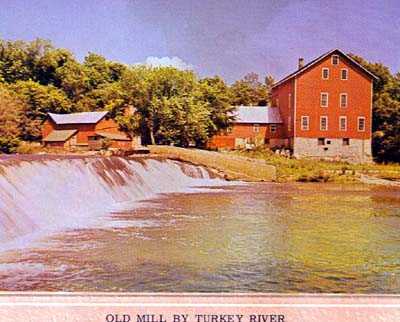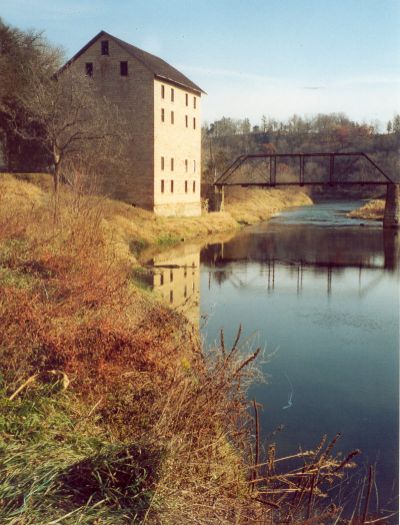Huge
Limestone Mill, Built in 1869, Deserted
Fifty-nine years ago a man spent $90,000 to establish
what he visioned as a thriving little city.
Today all that remains to tell the story of his
expeditures is a seven story mill and a two story
cooperage, both built of limestone and so perfectly
constructed that they will stand as long as the adjacent
cliffs from which the stone was quarried.
These buildings were built for Jack Thompson, pioneer of
Elkader, and are located on the east bank of the Turkey
river in the center of Clayton county. They are all that
is left of Motor, as the town was named.
In early days, the settlement contained several stores
and had the railroad been finished as planned, Motor
probably would have been a real town and Elkader but a
settlement.
Natures forces took a deciding hand in the destinies of
this promising town and decreed it can't stand. Floods
washed [illegible] on the narrow guage [illegible] had
been built [illegible] The [illegible] miles of Motor. It
invited extension of the tracks from McGregor to Elkader.
Chinch bugs came in hordes and made the growing of wheat
an impossibility. When there was no wheat to grind in the
vicinity, and no railroad to bring it in from other
sections, the mill with its thousands of dollars worth of
machinery was idle. In a little more than twenty years,
the entire property was sold for $12,000 and the valuable
machinery torn out and sold as junk.
The limestone for the buildings was quarried from the
hills above the river. A double track was laid. A drum at
the top of the hill over which a cable ran, operated two
cars that carried the stone down to the masons. The
weight of a full car going down drew the empty one up to
the quarry.
A dam was built and a fifty foot flume carried the water
down into the basement of the mill, where it turned the
huge water wheel.
The lower halves of the four large limestone burrs are
still in their original positions on the floor of the
third story. Oats, rye and barley were ground for stock
feed, corn was turned into meal, buckwheat ground for
pancake flour, and wheat was milled into bread and pastry
flour.
Perhaps the "jinx" that attends the proverbial
black cat may have had something to do with the failure
of the enterprise. A black cat on the window ledge in the
top story. One day a small boy climbed the stairs to this
window and pushed the cat off, down into the mill race.
Like most "kids," he was sorry the next instand
and started on the run down those six flights, hoping he
could get the cat out of that swift running water. Half
way down, he met a very damp cat coming up, on her way to
her favorite place to dry her fur and cogitate on the
ways of small boys.
An incident that came near being fatal, occurred during
the building of this mill. There came a day when Thompson
was unable to pay his laborers their weekly wages. They
threatened to hang him if he didn't come across, and the
scene was all set for the hanging. Thompson told them
they would have to go ahead and string him up, for he
could not produce the money.
The noose was slipped over his head and the end of the
rope thrown over a tree limb when a man from a
neighboring community drove rapidly up, grabbed Thompson
by the collar and carried him away to safety.
Another incident happened in the early days of this mill
that gave rise to a saying that is prevalent even today
over all that section, including Garber, Elkader,
Elkport, Communia and Littleport. Thompson owned many
horses and colts that ran loose and watered at the river.
Across the Turkey, which is about eighty feet wide at
that point, a spring of cold water poured out from the
hillside. One colt swam the river every day to drink this
cold water. This occasioned the expression, "As
foolish as Thompson's colt."
After the ties and rails for the railroad where all
washed awy and all hope was abandoned that the road would
ever be rebuilt, all the farmers around Motor used the
road bed as a wagon and sled road, over which to haul
their wood to the Elkader market. It was just wide enough
for a team and sled, but not wide enough for two teams to
pass. To avoid any such possible meeting, it was agreed
that no one should leave Motor for Elkader after 12
o'clock and those in Elkader should not leave home before
noon.
~Clayton County Register, Thursday, December 6,
1928 ~transcribed by S. Ferrall (March 2020)
|
![]()


